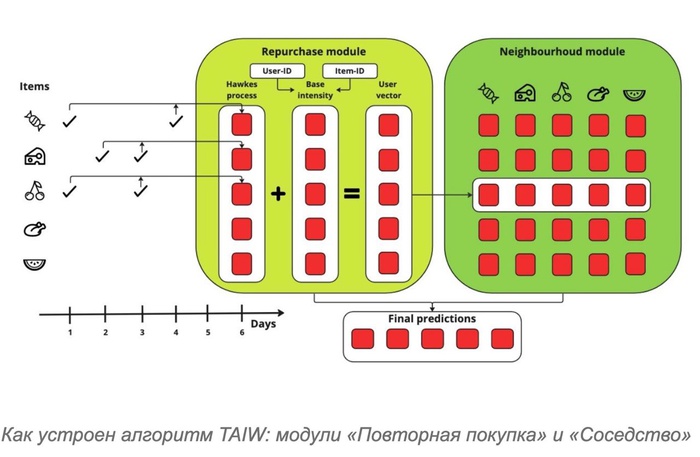Scientists at Tinkoff Research’s Artificial Intelligence Research Laboratory have developed a new TAIW (Time-Aware Item-based Weighting) algorithm that is capable of predicting the exact moment of purchase of a specific product online. This is stated in Tinkoff’s message.
The essence of discovery.
The TAIW algorithm more accurately predicts what products a customer will need in the near future, taking into account the exact moment of purchase. It takes into account both the composition of previous purchases of a given person and of users with similar profiles, and analyzes the exact moment of purchase of certain goods in the past.
This way, users receive highly personalized recommendations and companies can increase purchase conversions. Thus, TAIW knows in advance how long it will take the user to run out of products, and will offer to buy them at the right time.
“A person can buy a certain product with a unique frequency: for example, having a cheat meal with a certain product on the Saturday of every third week of the month. On other occasions, recommendations for this product or similar products are not relevant to the user, even though they have purchased them many times before. Previously, this data was rarely taken into account in recommender systems,” says Tinkoff.
The researchers conducted experiments with real data: in particular, they used the dataset from the online platform Taobao (part of the Alibaba Group). The results of TAIW experiments showed that the tool is more effective than its analogues in the next basket recommendation (NBR) task due to a more accurate classification of products based on their relevance at a given time.
According to the results obtained, the algorithm increases the accuracy of the recommendation system to 8%.
How is the algorithm different from other methods?
To predict repeat purchases, methods such as Markov chains (a mathematical model that helps predict future events based on past events) and recurrent neural networks (machine learning models that analyze the sequence of actions of the customer) are often used today. user), says the company.
However, Tinkoff points out that these tools do not always allow the frequency of purchases to be correctly taken into account when making forecasts.
The TAIW algorithm, in turn, consists of two modules: “Repeat Purchase” and “Neighborhood”. The “Repeat Purchase” module works based on the Hawkes process (a statistical model that allows us to understand time patterns and dependencies between events). The algorithm analyzes which products the user bought, how often and when the last purchase was. This module allows you to determine when specific products will be most relevant to a specific buyer.
The “Neighborhood” module allows you to describe the habits of users with similar preferences. This data is used to provide more varied recommendations for a given individual.
The research results were presented at the ACM RecSys conference on recommender systems, which took place in Singapore in 2023. It is organized by the Association for Computing Machinery, the world’s largest scientific and educational computing community.
Author:
Anastasia Marina
Source: RB
I am a professional journalist and content creator with extensive experience writing for news websites. I currently work as an author at Gadget Onus, where I specialize in covering hot news topics. My written pieces have been published on some of the biggest media outlets around the world, including The Guardian and BBC News.










